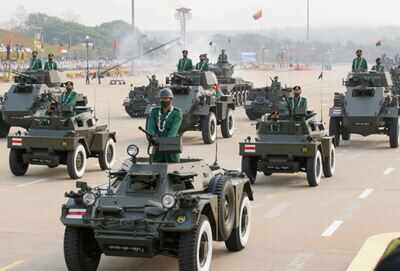
The Karen have cultivated a distinct cultural and political identity, which, alongside their unique weaving, construction and cuisine, manifests most starkly in their fervent desire for self-determination – something that draws the ire and aggression of the Tatmadaw, which overthrew the democratically elected government of Myanmar in a coup on February 1.Īs Myanmar’s major cities saw a bloody military crackdown against peaceful protesters, Tatmadaw aggression also turned towards the country’s peripheral states and the 20 or so ethnic armed groups within, including the Karen, with political as well as military wings.Īll of these groups, as well as the hundreds if not thousands of smaller armed militias peppered throughout the country, have had their own fraught histories of oppression, insurgencies and clashes with the military regime, and amongst themselves, since Myanmar’s independence in 1948. More than one and a half million ethnic Karen call this state, also known as Kayin, home. Paw Wah belongs to the Karen ethnic minority. Since most villages within Karen state are linked only by narrow jungle footpaths, elephants are used to transport heavier goods from one village to the next Tatmadaw air raids We have been in tears since we were young.” Two elephants stop at a loading bay in Ti Wah Kah Tah, Mutraw district. “They tied us up and threatened us … They threatened to kill everybody if they didn’t get the elephant. On this occasion, the Tatmadaw soldiers claimed the elephant was being used to transport ammunition for armed groups, but the villagers thought they were lying.

“At the time, my grandfather owned an elephant, and they demanded the elephant from him in return for our release.”Įlephants are valuable in Karen because they are commonly used for farming, as well as to transport heavy loads through the narrow jungle passes where cars cannot pass. “When I was 10, they arrested me and forced me and some other villagers to stay at their camp for 13 days,” she said. Paw Wah, who is a farmer, has lived all her life in Karen, a state in Myanmar’s southeastern reaches bordering Thailand, where walking distance through mountainous terrain and unrelenting jungle valleys is measured in days, not hours.Īt her neighbour’s house in the tiny jungle hamlet of Nyah Beh Ki, a two-day hike inland from the Salween River which separates Myanmar, formerly known as Burma, from western Thailand, Paw Wah recalled the incident from when she was a girl. When she was just 10 years old, soldiers came to her village and kidnapped her. All of them held up three fingers.Mutraw district, Myanmar – Paw Wah*, 36, was a child when she first experienced the brutality of Myanmar’s military, the Tatmadaw. On Sunday afternoon, dozens of people gathered in Yangon, carrying umbrellas in the rain and singing a lullaby in tribute to the protesters who had died. One photograph showed a soldier standing over a protester, who knelt in front of a sign that said, “The Yangon People’s Revolution cannot be defeated.” In the aftermath, soldiers flooded the streets of Yangon. He said he kicked the soldier, who fired in his direction but missed. When the vehicle plowed into the group, the injured protester said, he fell on the hood of the vehicle and a soldier struck his head with the butt of his gun. One of the injured protesters, who asked not to be named, fearing official retribution, said the protesters had been caught unaware because the military vehicle suddenly overtook a bus, which was right behind the protesters. “The military’s widespread use of brutal violence underscores the urgency of restoring Burma’s path to inclusive democracy,” the embassy said, referring to Myanmar by its former name. Despite the harsh punishments meted out by the junta, hundreds of people have organized flash-mob protests - including the one on Sunday - in cities and villages across the country to show opposition to military rule. 1 coup has infuriated people throughout the country and could very well spur more demonstrations. The excessive force used by the military as it has tried to quell protests against a Feb. One witness said the soldiers had also kicked the wounded protesters and arrested several others. The Irrawaddy and Myanmar Now, two news outlets that cover Myanmar, reported that five protesters had died. There were conflicting reports on fatalities. A video of the incident included the sound of gunfire, but it was not clear who or what was being fired upon. Soldiers fired into the group, according to two witnesses. The episode occurred on Sunday morning in Yangon, Myanmar’s most populous city. A military vehicle drove through a group of protesters in Myanmar on Sunday, resulting in fatalities and leaving at least eight people injured, according to the local news media, witnesses and video footage from the scene.


 0 kommentar(er)
0 kommentar(er)
